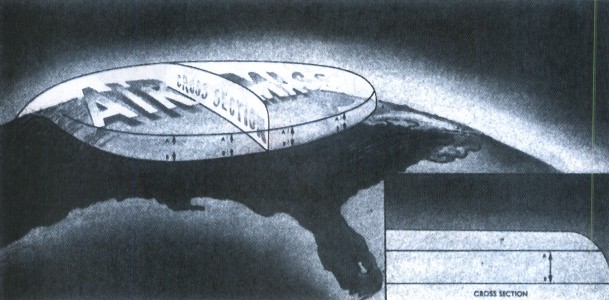Aviation Weather
full text of the classic FAA guide
AIR MASSES
When a body of air comes to rest or moves slowly over an extensive area having fairly uniform properties of temperature and moisture, the air takes on those properties. Thus, the air over the area becomes somewhat of an entity as illustrated in figure 58 and has fairly uniform horizontal distribution of its properties. The area over which the air mass acquires its identifying distribution of moisture and temperature is its “source region.”

Source regions are many and varied, but the best source regions for air masses are large snow or ice-covered polar regions, cold northern oceans, tropical oceans, and large desert areas. Midlatitudes are poor source regions because transitional disturbances dominate these latitudes giving little opportunity for air masses to stagnate and take on the properties of the underlying region.
AIR MASS MODIFICATION
Just as an air mass took on the properties of its source region, it tends to take on properties of the underlying surface when it moves away from its source region, thus becoming modified.
The degree of modification depends on the speed with which the air mass moves, the nature of the region over which it moves, and the temperature difference between the new surface and the air mass. Some ways air masses are modified are: (1) warming from below, (2) cooling from below, (3) addition of water vapor, and (4) subtraction of water vapor:
Cool air moving over a warm surface is heated from below, generating instability and increasing the possibility of showers.
Warm air moving over a cool surface is cooled from below, increasing stability. If air is cooled to its dew point, stratus and/or fog forms.
Evaporation from water surfaces and falling precipitation adds water vapor to the air. When the water is warmer than the air, evaporation can raise the dew point sufficiently to saturate the air and form stratus or fog.
Water vapor is removed by condensation and precipitation.
STABILITY
Stability of an air mass determines its typical weather characteristics. When one type of air mass overlies another, conditions change with height. Characteristics typical of an unstable and a stable air mass are as follows:
| Unstable Air | Stable Air |
| Cumuliform clouds | Stratiform clouds and fog |
| Showery precipitation | Continuous precipitation |
| Rough air (turbulence) | Smooth air |
| Good visibility, except in blowing obstructions | Fair to poor visibility in haze and smoke |
Table of Contents
Previous Section: Air Masses and Fronts
Next Section: Fronts
A PDF version of this book is available here. You may be able to buy a printed copy of the book from amazon.com.
